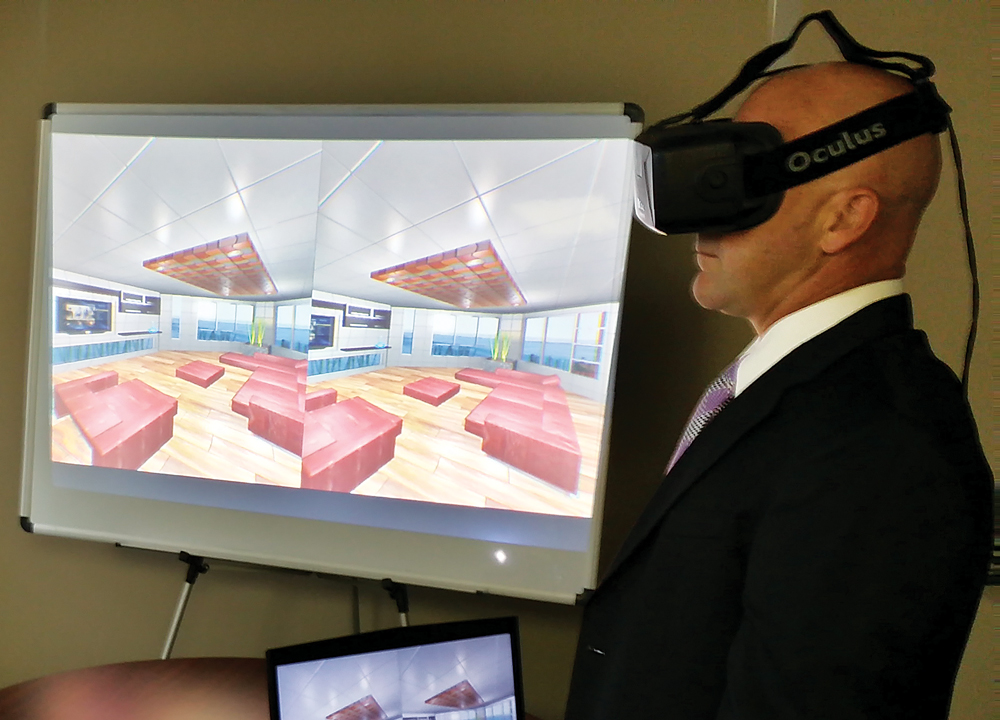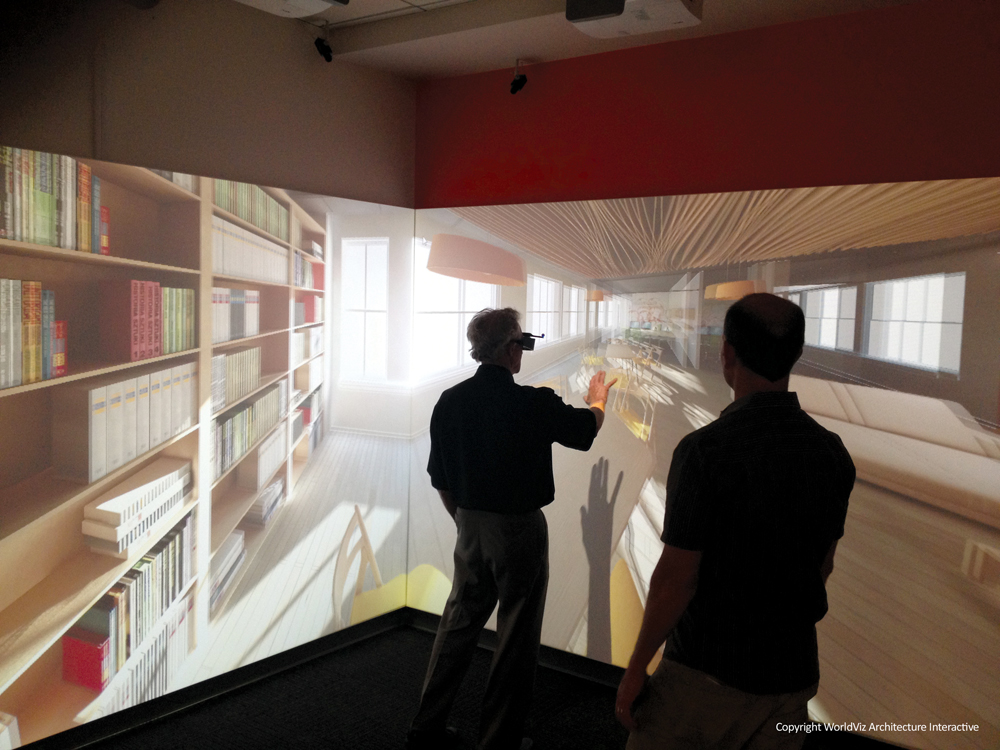When Facebook announced this past March that it was buying Oculus VR for a reported $2 billion, it signaled the beginning of a new movement in the U.S. tech sector—virtual reality for the masses.
One of the most successful Kickstarter campaigns to date—raising some $2.4 million from 9,522 investors in 2012—Oculus VR aimed to shake up the highly specialized, cost-prohibitive virtual reality hardware market by offering a low-cost, plug-and-play VR headset geared for gamers.
At $350, the Oculus Rift was a fraction of the cost of competing hardware solutions at the time (several similarly priced systems have since been launched), and a tiny sliver of the cost of fully loaded CAVE (computer-assisted virtual reality) systems and VR simulators popular in the military and scientific communities, which can run in the $20,000-30,000 range.
With Mark Zuckerberg’s deep pockets behind the technology, it won’t be long before every gamer is fully immersed in VR environments. “Oculus has the chance to create the most social platform ever, and change the way we work, play, and communicate,” said Facebook’s founder.
The technology is a natural fit for the AEC industry. Many firms are already building highly detailed BIM/VDC models of their most complex projects, so VR looks like the logical next step.
“Most people—including many in our industry—cannot read plans very well, so there are huge benefits in visualizing the design,” says Christopher Rippingham, BIM Manager and Construction Technology Specialist at DPR Construction. The firm is one of the industry’s early adopters of fully immersive VR modeling, operating a full-service VR showroom at its Redwood City, Calif., headquarters.
What you'll need to host truly immersive VR sessions
VR Headset or CAVE System
There are two approaches to creating a fully immersive VR experience: surround the users with a series of screens or projections, known as a CAVE (computer-assisted virtual environment), or have them wear headsets. Headsets are much less costly—the Oculus Rift starts at $350. Advanced 3D TVs and computer monitors can also be used, but the experience will be less immersive.Beefed-up Workstation
VR sessions require tremendous processing power. Attempting to host a VR session on a MacBook Pro will likely result in a choppy, sluggish experience for the user. VR technology provider WorldViz recommends that VR workstations have an i5 or i7 processor with high clock speed, at least 8 gigabytes of RAM, and a dedicated graphics card.Advanced Controller
For power users, a keyboard will suffice for navigating a VR model. Not so for novices, especially clients. Our experts advise you to look into the many gaming controllers, data gloves, hybrid keyboards, joy sticks, and other VR controllers on the market. They’re relatively inexpensive and can greatly enhance the user experience and productivity during VR sessions.Dedicated Showroom Space
The beauty of modern VR headset technology is its portability. Sessions can be held virtually anywhere—at a client’s office, a Building Team co-location site, even the job site. Our VR experts recommend creating a dedicated showroom area for VR sessions, with ample, professional-looking space, a powerful workstation, and all the tools and accessories needed to create a great experience for clients.Accessories
VR technology firm PocketCake offers a mobile workstation, the VRSCA, that allows up to eight persons to navigate a VR model simultaneously for group coordination meetings or guided tours. WorldViz sells standard and custom avatars that can be placed in VR models to make the spaces more lifelike. The firm also offers a 3D sound system for more realistic acoustics.
There, DPR worked with VR technology provider WorldViz to install a corner CAVE (with multiple projections to create a 90-degree view) and a fully immersive, headset-based walkable VR environment. The firm has used advanced VR for several applications, including constructability reviews and virtual mockups.
“The technology helps us drive a more predictable outcome for clients, whether that’s the look and feel of a design or a specific detail that is going to be constructed,” says Rippingham. The ability to immerse clients in the space they’re eventually going to occupy “helps generate excitement and creates a volunteer army to help us with some of the issues we need to tackle,” he says.
Suffolk Construction doesn’t have an in-house VR studio, but the firm has applied advanced VR on several projects to date, most recently on the Brigham and Women’s Hospital’s 620,000-sf, 13-story Brigham Building for the Future, currently under construction in Boston.
“As an experiment, we modeled the entire project and had the doctors and support staff walk through the proposed spaces using a CAVE environment,” says Peter Campot, the firm’s Chief Innovation Officer and President of Healthcare, Science and Technology. “We told them that they could change anything they wanted during a two-week review period, but after that they could only change colors. We got tremendous buy-in, and there have been minimal changes so far.”
By using VR, Suffolk has almost completely eliminated physical mockups on select healthcare and S+T projects, while greatly reducing change orders—resulting in considerable savings.
“We’re looking at a process of walking every client through a project virtually before we build it,” says Campot. “Nine times out of ten, the reason they have changes is due to the client not understanding what they agreed to. If we can walk them through that, we eliminate that unknown.”
Campot and Rippingham identified five solid applications for VR in the AEC field:
Virtual mockups. VR reduces the need for costly physical mockups and can be a more effective tool. Virtual mockups can be tweaked based on user input relatively quickly and retested in an iterative design process. “You can refine the details much faster,” says Rippingham.
Constructability reviews. The technology offers a much richer environment for hashing out the details on the problematic components of a job. “We’re getting away from the ‘figure it out in the field’ mentality,” says Campot. “It all starts with getting it right in the model.”
Facilities operations training. Even before the building is completed, the Building Team can walk the facilities management staff through the inner workings of the design, conduct basic training on the systems and equipment, and gather feedback for improvement.

An architect at AECOM’s Kansas City, Mo., office experiences a virtual reality simulation of a high-rise condo design concept. VR technology provider PocketCake created the VR model and powered the demonstration using its VRSCA mobile workstation and the Oculus Rift headset. PHOTO: COURTESY POCKETCAKE
Safety hazard analysis. “We’re putting our teams into the virtual reality environment so that they can more effectively analyze projects for fall hazards and other potential safety issues,” says Rippingham.
Real estate sales and marketing. VR can be a powerful tool for commercial real estate developers in preselling their space, especially on speculative office and condominium projects, where presales can greatly affect financing.
5 VALUABLE TIPS FROM EARLY ADOPTERS
Here’s some helpful advice from our experts on implementing VR in your firm:
1. Define the desired outcomes up front. Manage client expectations, says DPR’s Rippingham: “When a client says they want to look at their space in a virtual reality environment, we ask them what they’re trying to achieve and we make sure they’re aware of the level of effort required for each use.”
2. Be prepared for extra work—and costs—to create the VR model. You can’t just throw Oculus Rift on your BIM model and start navigating. The BIM model needs to be converted for VR use, which takes time and may require the expertise of a third-party specialist.
“This is a limiting factor due to the fast pace in which designs evolve on most projects,” says Tim Meyers, Designer with 360 Architecture. “The technology seems to be improving rapidly and may eventually be integrated with our current design tools so that we [will be] able to use it more efficiently on projects.”
3. Designate a tour guide for client sessions. Clients can easily get lost or disorientated when attempting to navigate a VR model solo. Look into VR setups that can accommodate multiple users simultaneously.
4. Beware of motion sickness, especially with the headset. Have people walk or move slowly through the model to avoid queasiness, advises Campot. The last thing you need is to get your client nauseous.
5. Consider adding avatars to the models. This is especially helpful for virtual mockup applications; for example, a surgeon avatar could simulate the steps required to conduct a procedure in an OR. “We didn’t do that initially and quickly realized it has a tremendous amount of value,” says Campot. “The client’s level of understanding of the space starts to kick in when they can test out the space for safety and efficiency by simulating procedures.”
Related Stories
Adaptive Reuse | Mar 21, 2024
Massachusetts launches program to spur office-to-residential conversions statewide
Massachusetts Gov. Maura Healey recently launched a program to help cities across the state identify underused office buildings that are best suited for residential conversions.
Legislation | Mar 21, 2024
Bill would mandate solar panels on public buildings in New York City
A recently introduced bill in the New York City Council would mandate solar panel installations on the roofs of all city-owned buildings. The legislation would require 100 MW of solar photovoltaic systems be installed on public buildings by the end of 2025.
Office Buildings | Mar 21, 2024
BOMA updates floor measurement standard for office buildings
The Building Owners and Managers Association (BOMA) International has released its latest floor measurement standard for office buildings, BOMA 2024 for Office Buildings – ANSI/BOMA Z65.1-2024.
Healthcare Facilities | Mar 18, 2024
A modular construction solution to the mental healthcare crisis
Maria Ionescu, Senior Medical Planner, Stantec, shares a tested solution for the overburdened emergency department: Modular hub-and-spoke design.
Codes and Standards | Mar 18, 2024
New urban stormwater policies treat rainwater as a resource
U.S. cities are revamping how they handle stormwater to reduce flooding and capture rainfall and recharge aquifers. New policies reflect a change in mindset from treating stormwater as a nuisance to be quickly diverted away to capturing it as a resource.
Plumbing | Mar 18, 2024
EPA to revise criteria for WaterSense faucets and faucet accessories
The U.S. Environmental Protection Agency (EPA) plans to revise its criteria for faucets and faucet accessories to earn the WaterSense label. The specification launched in 2007; since then, most faucets now sold in the U.S. meet or exceed the current WaterSense maximum flow rate of 1.5 gallons per minute (gpm).
MFPRO+ New Projects | Mar 18, 2024
Luxury apartments in New York restore and renovate a century-old residential building
COOKFOX Architects has completed a luxury apartment building at 378 West End Avenue in New York City. The project restored and renovated the original residence built in 1915, while extending a new structure east on West 78th Street.
Multifamily Housing | Mar 18, 2024
YWCA building in Boston’s Back Bay converted into 210 affordable rental apartments
Renovation of YWCA at 140 Clarendon Street will serve 111 previously unhoused families and individuals.
Healthcare Facilities | Mar 17, 2024
5 criteria to optimize medical office design
Healthcare designers need to consider privacy, separate areas for practitioners, natural light, outdoor spaces, and thoughtful selection of materials for medical office buildings.
Construction Costs | Mar 15, 2024
Retail center construction costs for 2024
Data from Gordian shows the most recent costs per square foot for restaurants, social clubs, one-story department stores, retail stores and movie theaters in select cities.

















